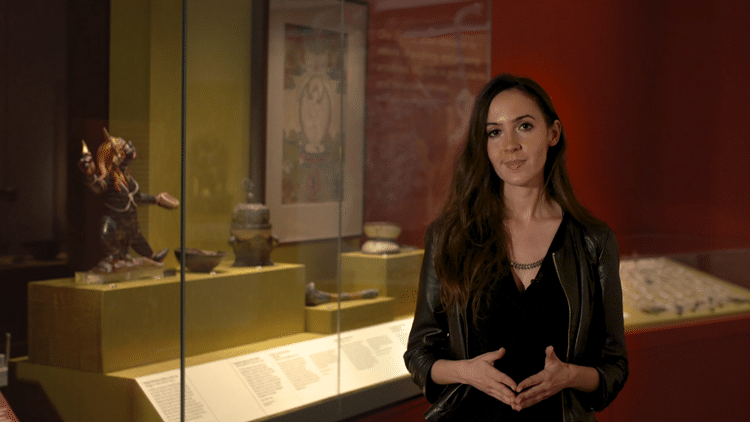30 Artists 30 Years, Dr Imma Ramos
BF: You hold an amazing position at The British Museum as Curator of the South Asian and Himalayan collection. What initially drew you to this subject area and especially, why Tantra?
IR: The power of the creative imagination has always been central to Tantra – this is what drew me to the subject. Visualization, which is fundamental to all aspects of Tantric practice, privileged material aids as practical tools of embodiment far more than any other South Asian religious tradition had done. This resulted in the creation of complex ritual instruments, sculptures and paintings which served to fuel the Tantric practitioner’s imagination and practice. Imagination was also key when it came to reading Tantric texts themselves, since they could be interpreted on both literal and symbolic levels. The power of the imagination also plays a role when the gaze is shifted and those outside the Tantric social milieu – from Mughal rulers to the hippies of the New Age movement – interpret and visualize the ‘exotic’ mystique of Tantra and its practitioners. I was fascinated by the fact that Tantra has constantly adapted and transformed in response to its social, political and cultural environments – for instance, in the association of Tantric goddesses such as Kali with Mother India by Bengali revolutionaries and artists during the British colonial period; and in the 20th-century appropriation and redefinition of Tantra by Western popular culture during the 1960s. Tantra’s one recurring thread (to take its literal meaning, ‘to weave’, as a central metaphor) has been its role as a fundamentally countercultural movement, from medieval India to 21st-century Britain.
It was during my PhD that I first began to learn more about Tantra as a countercultural philosophy via an exploration of its impact in colonial India. My thesis examined how Tantric sites (Shakti Pithas) were reimagined and harnessed as revolutionary centres of power by Bengali anti-colonial writers and artists during the late 19th century (‘Pilgrimage and Politics in Colonial Bengal: The Myth of the Goddess Sati’, 2017). When I arrived at the British Museum 5 years ago I was struck by the fact that we have one of the most comprehensive collections of Tantric material in the world, and were therefore in a unique position to present a history of Tantra through objects that could challenge assumptions about this rich philosophy in stimulating ways. The exhibition and accompanying book present the first historical exploration of Tantric visual culture from its origins in India to its reimagining in the West. Above all, the aim is to provide the tools for recognizing certain signs and signifiers (from skull-cups and weapons to sexual acts) as specifically relating to the Tantric imaginary, in order to understand how this philosophy has been visualized throughout history. From its beginnings, Tantra has challenged religious, cultural and political conventions around the world; the show charts Tantra’s radical potential for opening up new ways of seeing and changing the world.

BF: We were thrilled to be able to support the exhibition on Tantra which you curated at The British Museum this year and are really pleased with the extensive catalogue and free public programme. For our international readers who can’t get to the exhibition in person, what would you say is the best way for them to get an understanding of the subject? Are there particular scholars who inspired you and your research?
IR: We were very keen to ensure that people from outside London would have the opportunity to experience the exhibition even if they couldn’t make it in person, so we recently released a virtual tour of the show which provides an introduction to Tantra as well as the highlights on display, including masterpieces of sculpture, painting, prints and ritual objects.
Viewers can learn about Tantra’s link to successive waves of revolutionary thought, from its sixth-century transformation of Hinduism and Buddhism, to the Indian fight for independence and the rise of 1960s counterculture. For more in-depth online offerings, there are also blog essays on the British Museum website exploring key themes in the exhibition (‘What is Tantra?’; ‘Demystifying Tantric sex’, and ‘Kali rises in the East’)
The Events team have prepared a series of wonderful online events running throughout the exhibition duration. These include a performance by acclaimed musician Parvathy Baul streamed live from India, as well as the creation of a sand mandala dedicated to the goddess Vajrayogini streamed live from Bhutan (airing in January). Hosting these events online has enabled us to reach a wider global audience, and they can all be watched on our youtube channel Here people can also listen to fantastic talks with acclaimed scholars, including Vidya Dehejia, Madhu Khanna, James Mallinson, Nida Chenagtsang and Ian Baker.
There are many more scholars who have published exciting, accessible research on Tantra and related practices. For general introductions I would recommend ‘The Hindu Tantric World’ by André Padoux (2017), ‘Tantra in Practice’ by David Gordon White (2000) and the relevant sections of ‘An Introduction to Hinduism’ by Gavin Flood (1996). For more specialist angles on the subject I would recommend publications by Hugh Urban, Shaman Hatley, Alexis Sanderson, Ronald Davidson, Rachel McDermott, June McDaniel, Robert Linrothe, Christian Wedemeyer and Judit Törzsök.

BF: What are the areas of South Asian and Himalayan culture that you would like to explore next? Which objects in the British Museum collection are you excited to delve into more?
IR: I’m going to be exploring colonial-era material in the collection, with the aim of decentering Eurocentric narratives and emphasizing the voices of those under British rule between the late 19th and early 20th centuries. I’m keen to uncover stories that challenge assumptions about the nature of Empire in stimulating ways; ones that foreground multi-vocal experiences of imperialism, including traumatic histories and the recovery of instances of cultural erasure. As part of this process I will be exploring ways of opening up these collections for schools, community groups, artists, historians and activists, inviting them to interact and respond to the material in creative and emancipatory ways. This will involve a need for institutional self-reflexivity and an acknowledgement of Empire as the context for many of the Museum’s permanent displays.
Biography
Dr Imma Ramos is curator of the South Asia collections at the British Museum in London where she works on material dating from the tenth century to the present. Her research interests revolve around the relationship between religion, politics and gender in South Asian visual culture. She is the author of Pilgrimage and Politics in Colonial Bengal: The Myth of the Goddess Sati (Routledge: London & New York, 2017) and has published in journals including Art History (2014), The Journal of South Asian Studies (2015) and The Journal of Decorative and Propaganda Arts (2015). Imma completed her BA, MPhil and PhD in Art History at the University of Cambridge.
Interviewed in December 2020 by Chelsea Pettitt, Head of Arts


